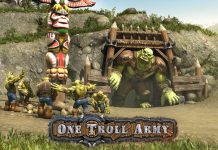Grinding Gear Games have developed themselves an excellent Diablo-clone, free-to-play, action MMORPG in the shipwreck survivor game Path of Exile. In the game, you’re trust into the unfavorable position of being washed up on the shore and must make your way to a refugee camp. The game does an excellent job of making you feel dirty and alone while you fight your way through undead foes while gritting sand in your teeth.
Yes, I’m sure I’m going to take some flack from many for comparing it over and over to Blizzard’s flagship 1990s game product and MMO, but this is exactly what Path of Exile reminds me of as I play it. Furthermore, it should remind you of it too—this game borrows a lot of the best gameplay from Diablo and does its best to innovate on that foundation and it comes up with a large number of very good ideas. In fact, I fully intend to expound upon them and you let me know if it fits your expectations.
Now, Grinding Gear Games have let us into the game in an early beta stage. That means that the game isn’t fully in production, not everything is done, and there’s a lot of bugs laying around (and not just the kind that drop loot.) As a result, my first impression will be a little bit incomplete and I’m going to levy time on the parts of the game that I find particularly interesting or innovative and not really give you a critique of what parts might fall down.
No sense in beating them up when they’re still setting up.
However, as you’ll discover, overall it’s a pretty good game and it does a great job of distinguishing itself from every other Diablo-clone to ever hit the free-to-play MMO market.
Graphics and sound: The hyper-realistic texturing is more of a drawback but it looks nice.
As an isometric action-MMORPG, Path of Exile really went all out in getting extremely realistic looking environments and characters. The only problem is, I don’t like it very much. I do love how the beach looks very beach, the caverns are dripping and shiny with moisture, and the wetlands are covered with moss and sparkling water pools. It’s sometimes just a little too much and it’s often hard to separate my character from the environment without much contrast.
At first I thought the effect came about because the graphics were poor, but really they’re quite good, and a lot of technology and care went into designing them.
Most of the enemies in the game are humanoid (with some obvious exceptions) but they’ve been painstakingly rendered and textured. The game even goes out of its way to stick arrows out of them when I actually turn them into pincushions as an archer. That’s a detail that I didn’t expect to find as part of a game of this sort. The developers certainly have thought a lot about how the graphics affect the player’s ability to approach the environment and play the game.
Needless to say, the life of a shipwreck victim is dismal and the landscape is uninviting; but I really enjoy looking at it.
Sound in this game is perfectly reasonable, in fact—and I’m going to keep saying this—the music seems extremely reminiscent of Diablo II. It swells and fades, keeps to itself, and generally remains a jaunty elevator tune that doesn’t offend but also doesn’t stand out. If I heard it again, I might recognize it; but really it did a good job of setting the mood for each of the locations and I mostly ignored it.
As for dying sounds, weapons, etc. They’re all on part with what I’d expect form a waves-of-monsters, Diablo-clone, hack-and-slash action game.
Gameplay: It’s Diablo II … but different. No really!
Path of Exile reminds me a lot of Blizzard’s Diablo II right down to much of the interface. In fact, it reminds me of the game so much that I’m going to have to review the gameplay based entirely on how it is similar to and differs from Diablo II. This isn’t necessarily a bad thing at all, Blizzard basically set the stage for a lot of future MMOs by producing some of the best gameplay elements of their time and that people are continue to use them.
In the same fashion of Diablo, Path of Exile provides identify and town portal scrolls. Many magic items require the former to identify them before they can be equipped on the character; and the latter scrolls are useful for getting the hell off the battlefield. However, as a twist on the Diablo use of these items, PoE makes them—and a few other consumables including whetstones (weapon buff), armor shards (armor buff), orbs of transmutation (magic item makers), etc.—into the in-game currency. Instead of trading gold for items, I found myself hawking my consumables for weapons and armor: two identify scrolls, a town portal, and an orb of transmutation you say? Sure thing!
This particular element of gameplay fits directly in with the shipwreck narrative. What use would these people have for gold when they’ve got these useful items laying around (although what a weaponsmith does with an identify scroll is beyond me.) Also, it strongly encourages the players themselves to do their own bartering and trading with items dropped from enemies. Inventories are small, magic is common, and there’s no gold economy: just equipment and consumable items.
Just like Diablo, Path of Exile offers the players heath and mana and also applies potions for them to fill both; when a potion is used the fill on their health and mana is slow (it does so over time) which means that I find myself judging when I need the health or mana and hit the button before I might die or run out. For an innovation on Diablo, PoE uses potion bottles instead of individual consumable potions—in fact, these bottles contain a set number of charges (recharged via killing monsters) and the bottles themselves can have their own magical effects when in use. One of my favorites would de-freeze me when I chugged the health potion and would convey a greater resistance to cold damage while it refilled my health during the over-time phase. In this fashion, a player can never run out of mana or health potions: just kill more monsters.
Just like Diablo, Path of Exile uses attribute points and talent trees; the twist here is a big one: skills are not bought, they’re slotted like gems and talent trees increase passive skills and attribute points. In fact, the passive skill trees are vast and loop into themselves as they branch out. There are three major skill branches: dexterity, strength, and intelligence. Each time a passive skill is chosen it opens up further parts of the talent tree (which can even mix into each of the others) meaning that a player following one tree can slowly wind into another if there are passive skills nearby that fit their style of play. Picking from the passive talents also increases attribute points. That is to say, if I chose a low level dexterity skill, it will give me a large number of dexterity points, a smaller number of intelligence (or strength) points, and finally an even smaller number of strength (or intelligence) points. The numbers depend on the type of skill and its proximity to the other attribute trees.
The branching mechanism of the passive skills forces players to think about their playstyle and choose how they want to develop their character. Just like Diablo equipment require particular attribute point levels to equip as higher levels come along so players can quickly find themselves locked into certain roles.
The skills-as-gemstones really does diverge completely from Diablo—although the idea of slotting gems into equipment is totally a gameplay element taken from them, the meta effect is not. Class skills are picked up from gems dropped by monsters and are slotted and developed by placing the gems into worn items. Gems come in a variety of colors as do sockets and only socket-gem matches work; this forced me to think about what my upgrades would do for my character play and what abilities I wanted to keep and what I was willing to give up for higher attributes, boons, and the like from new equipment.
I especially liked how most of the equipment is rusted, bent, damaged, or otherwise fashioned from driftwood or planks from a ship. In fact, it’s beyond Robinson Carusoe in the shipwreck factor. When the developers say gritty they’re not kidding.
Conclusion: You got a good thing going, for a Diablo-clone.
If you’re a staunch Blizzard advocate or dyed-in-the-pixels against someone else taking what worked well in the past and modifying on it, perhaps Path of Exile is not for you. However, if you enjoy hours of mindless slaughter of critters and running around as a shipwreck victim with nifty-wifty-powers, swords, bows, and smashy-clubs you’ll probably have a lot of fun.
While Path of Exile is still building itself, it’s already got quite a community within its virtual walls and there’s people trading numerous items.
The game world is still small; but it has a lot that it could grow into.
In fact, I barely scratched the surface by leveling three characters to level 12 and then moving on so that I could get an idea of what each aspect of the game worked like.























Great FI. Too bad beta keys are given out at such slow and random pace.
I know! It was a little bit strange looking at the little timer saying when the next beta key would be dispensed. I wonder if the data they’ve gotten from that experiment will help them decide how to do it again in the future.
I believe that Path of Exile’s build-to-beta nature is what caused them to do that. They’re almost in an alpha stage right now. The game’s core features all function quite well — although they warn there will be bugs, I didn’t see many — but the secondary features, such as selling to merchants, didn’t work yet. Although, in a way not being able to sell to merchants added a lot to the shipwreck atmosphere. It forced players to rely on trading between one another for many of the necessities and it made less sense to keep stuff in inventory that I didn’t need.